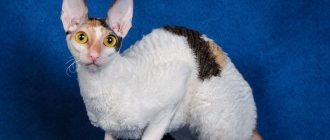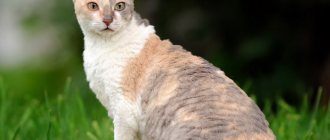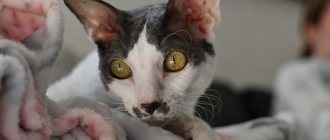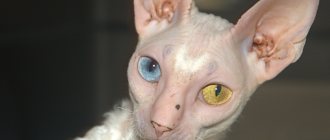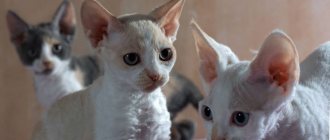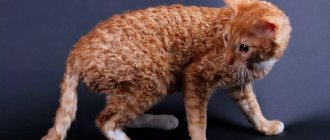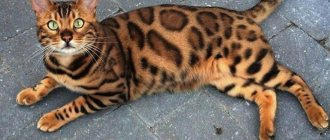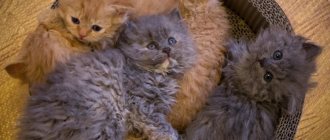If you go to visit your friends and see an animal that looks like a cat, but is covered with curly hair and has long ears, do not think that this is an “alien.”
It seems that this animal got its ears from a bat, its skin from an astrakhan sheep, and its muzzle from a kangaroo. The breed is called Cornish Rex and they love their owners very much, they are brave, smart...
This is the case when breeders took into account the wishes of fans of the unusual appearance of cats - and created the Cornish Rex breed.
Looking at his face, you might think that this is a fairy-tale elf or a bat (some people have associations with the head of a kangaroo). Slanting expressive eyes, an elongated profile and disproportionately large ears will not allow you to confuse this breed with other representatives of the cat tribe.
The second characteristic feature is a soft curly coat. The back is completely covered with silky waves. The standard allows for both single-color and three-color painting. There are no strict criteria for colors; it is only important that the transition from one color to another has clear boundaries.
To all the advantages of the Cornish Rex, one more important factor can be added: the animal’s fur does not have guard hairs and does not fall out in large quantities. If there are allergies in the house, perhaps this particular breed will not provoke negative reactions.
Often cats of this breed have eyes of different colors. Above the organs of vision there are pronounced curly eyebrows. There is an opinion that a blue iris indicates deafness, but there is no scientific confirmation of this opinion. The Cornish Rex is endowed by nature with very sensitive hearing; it picks up sound vibrations that are inaccessible to humans.
Another amazing characteristic is cats' paws. The front limbs, as usual, have 5 fingers, and the hind limbs have 4. The animal does not notice this anomaly and runs, jumps, climbs trees... furniture, wallpaper and curtains perfectly. And if you carefully examine your pet’s foot, you will see webbing between the toes (just don’t think that you have a waterfowl breed; the Cornish Rex hates swimming).
The body of the Cornish Rex is graceful and flexible. There is a thickening at the tip of the tail. Cats are not large in size: the weight of a male does not exceed 4.5 kg, and that of a female – 3 kg.
At exhibitions, an animal may be disqualified for the following defects:
- Bald patches on the body;
- Too thick build;
- Very short or excessively shaggy coat;
- Short legs or tail.
The history of the appearance of the Cornish Rex cat breed
The progenitor of this breed was found in 1950 in England, in the city of Cornwall. Nina Ennismore saw more in the baby than just a purr. They decided to call him Kalibunker. While observing the pet, the owner discovered in him the makings of a new breed. When Kalibunker grew up, she decided to bring the already mature cat together with his mother, and then with other cats. As a result, cats of this breed appeared with both curly and even hair.
In 1957, Nina published photographs of her unusual pets in Life magazine. As a result, her kittens were almost immediately purchased by felinologists. And in 1962, these cats acquired popularity and a new name - “Cornish Rex”, or “Cornish Rex”. In 1957, they began to be bred in the USA. The breed was officially recognized in 1967 in England, and a standard was developed at the same time. And by 1983, the Cornish Rex was recognized by all cat associations.
Subsequently, two directions of development of the breed arose: European and American. Two new intrabreed species of rex have appeared:
- the American look has a more fine-boned and elegant physique, as well as a graceful gait; many breeders and lovers of Cornish cats compare them with porcelain figurines; the ears of these cats are larger than those of the European species, and the limbs are longer;
American Cornish Rexes are more elegant than European ones.
- European species retained the attributes of the first rexes - a stocky body and not so large ears.
The European Cornish Rex has a stronger looking body
But they still have one thing in common - curls on their fur and a unique kind and affectionate character.
Cornish Rexes are sometimes called mutants. And there are reasons for this: there is an assumption that the progenitor of this breed had curly hair due to the radiation emitted by tin mines. And if it weren’t for the owner’s efforts to create a new breed, these beauties would not exist now.
Table: positive and negative qualities of Cornish Rex cats
| Advantages | Flaws |
| A rare breed that attracts attention. | Not everyone likes the “alien” appearance. |
| Magnificent curly wool, like a lamb's. | Wool requires careful care. |
| An active, energetic cat with whom you will never be bored. | Trying to attract attention, it can be annoying. |
| Companion cat, loves people. | Constantly needs the attention of the owner. |
| She is not prone to genetic diseases and has good immunity. | Has increased sensitivity to analgesic drugs. |
| Can eat both special food and natural food. | Prone to overeating and being overweight. |
| Gets along well with other animals. | High cost of kittens. |
| Like a dog, it is able to follow commands and wag its tail. |
Features of the Cornish
Cornish Rexes are medium-sized cats. Their height at the withers is 23–27 cm. At first glance they may seem very fragile, but in fact their muscles are well developed. The head is small and egg-shaped. The ears and eyes are large. The tail is long and thin.
The hallmark of this breed is its wavy and soft wool, which makes them look like a shorn ram. Guard and cover hairs are absent. The curls on the coat are well defined. Cornish Rex can be any color.
Photo gallery: Cornish Rex colors
Black Cornish Rexes have a very mysterious appearance.
The standard allows any colors of Cornish cats
The tricolor color of the Cornish is also not uncommon.
White Cornish people often have blue eyes
A special feature of the Cornish Rex breed is its curly coat, which is unusual for cats.
Adult cats can weigh up to 4.5 kg, and male cats - up to 3 kg.
There are several varieties of rex. The most common are:
- Cornish Rex;
- Devon Rex;
- herman rex;
- Selkirk Rex.
Photo gallery: varieties of rex
Herman Rex has a very strong build
Devon Rex and Cornish are often confused, although they have a number of significant differences.
Selkirk Rex cats look like curly Persians
Most often, the Cornish is confused with the Devon Rex. But they have a number of very significant differences.
Table: differences between Cornish and Devon Rex
| Cornish Rex | Devon rex | |
| Head shape | Elongated, ovoid | Heart shaped |
| Nose | Straight | With a clear transition to the forehead |
| Ears | Quite large, set high | Very large, low set |
| Wool | Wave-like curls directed towards the skin | The curls do not have a clear direction, the guard hair differs from the undercoat in length and thickness |
Devon Rex (left) is quite different from Cornish Rex (right)
Video: differences between Cornish and Devon
https://youtube.com/watch?v=KNxWeduW2dg
The appearance of the Cornish Rex is a combination of originality and sophistication
Despite some differences between the two standards (European and American), both types of Cornish are distinguished by features characteristic of this breed:
- these are miniature animals, weighing from three to four and a half kilograms, and height - from 23 to 27 centimeters;
- These cats have a long torso, proportional shoulders, chest and hips. All contours of the body are gently curved;
- The paws are graceful and slightly oval. Cats have five toes on their forelimbs and four on their hind limbs. Upon careful examination of the foot, webbing can be seen between the toes;
- the tail of the Cornish Rex is flexible and long, and thickens closer to the tip;
- the unique appearance of these cats is created by a small wedge-shaped head with pronounced cheekbones;
- the nose is one third of the length of the head, with a clear bridge and hump, which resembles a proud “Roman” profile;
- Another striking feature of the breed is its large, straight-set, wide ears, pointed at the tips;
- According to the standard criteria, the eyes of these cats must match the color. As a rule, they are large, very expressive, oval, widely and slightly slanted, yellow or green in color.
An animal may be disqualified at an exhibition for:
- rare wool;
- bald spots on the body;
- coat that is too short or excessively shaggy;
- presence of guard hairs;
- short legs and tail;
- wrong number of fingers;
- signs of lameness in the hind limbs;
- health problems.
Features of wool and richness of colors
The main distinguishing feature of the Cornish is its short, curly coat, which lacks guard hairs. This gives it a special softness. These cats also have long and curly eyebrows and whiskers.
Cornish Rexes are distinguished by a variety of colors:
- white. These cats usually have blue or golden eyes and pink paw pads;
- black. With this color there should be no haze or mixing of colors;
- cream. The paw pads and nose are pink, and the eyes are golden;
- red. It is distinguished by amber eyes, paw pads and a brick-colored nose;
- blue. The color should be evenly distributed throughout the body, including the nose;
- bicolor - a combination of two colors;
- Calico - white with red or pastel points, as well as black and red spots. The eyes of these Cornish are especially interesting, as they can be two-colored.
Rarer colors are smoky (black and blue), tabby - a patterned color, tortoiseshell and chocolate.
Associations of felinologists recognize Cornish Rex cats in all colors except Siamese and white
Photo gallery: Cornish Rex colors
White cats have beautiful blue eyes
Black Cornish cats have noses and paw pads that match their fur.
Cream Cornish Rexes have soft pink paw pads and noses.
Red is one of the brightest colors
Blue Cornish Rexes actually have a coat of noble gray color
The seal point color of the Cornish Rex was inherited from their Siamese relatives.
The fur of bicolor Cornish Rex dogs can be a combination of any two colors.
According to popular belief, calico cats bring good luck.
The ancestor of the Cornish Rex breed was the domestic “tortoise” cat.
The “delicious” chocolate color of the Cornish is considered one of the rarest
Tabby cats resemble wild ancestors
Character of the breed
Cornish cats are considered one of the most intelligent cats, as they:
- do not mark the house as their territory;
- do not try to bite the owner or hurt him;
- don’t jump on furniture in search of something tasty;
- They have a kind and overly trusting nature.
All Cornish Rex kittens are playful and cheerful. And representatives of this breed remain like this forever. They are very smart and trainable.
Corniches are very acrobatic. My curly-haired darling simply loved to climb onto the highest cabinet in the room and jump from there onto the bed. Every time I was surprised how she managed to get there.
Their amazing character makes these cats ideal partners for their owner:
- they are very obedient;
- have high intelligence;
- understand how to behave if the owner is not in a good mood;
- they have absolutely no aggressiveness;
- get along well with children and other pets;
- devoted to their master;
- are loyal to strangers;
- love communication.
But this breed also has its disadvantages:
- they are very curious;
- have a high price;
- eat a lot;
- cannot stand loneliness;
- quite noisy;
- require a lot of attention.
Cornish people do not like noisy companies. My cat often hid when drunk or loud guests arrived.
Video: Cornish Rex playing
Character of the Cornish Rex: salvation for the lonely, reward for the warm ones
Reviews from breeders about the character of the Cornish Rex confirm that such cats are smart, non-aggressive, hyperactive and incredibly sociable. Representatives of this breed can rightfully be called companions; they only feel good when they are close to their owner. Cornishes are inquisitive, love to play (especially hunt for “prey”) and resemble kittens until old age. These cats are not only energetic, but also quite hardy.
Cornish cats are energetic and playful
It’s not for nothing that Cornish Rex dogs are jokingly called “Cotops.” First, they express their emotions by wagging their tail. Secondly, these cats are trainable; they can be taught to fetch a ball and carry out other simple commands. True, you will have to first interest the pet. When teaching tricks, focus on those that your cat likes, not just you.
You should not think about purchasing a Cornish Rex if you associate a cat with independence, inconspicuousness and calmness. Cornishes are animals that need the attention and affection of their owners, their constant presence. Having appeared in the house, the kitten will quickly choose the one to whom it will become attached with all its soul, but it will treat all family members in a friendly and affectionate manner. In addition, Cornish dogs have a friendly character and are able to get along well with other pets.
Authors of information articles on the Internet most often speak of representatives of the breed as well-mannered and calm animals. They are supposedly not prone to marking territory, yelling and being disruptive. However, reviews from owners often indicate the opposite. Therefore, you should not expect that any Cornish Rex will behave in the same way as its brothers. Every living creature is unique.
Cornish Rex - a unique companion cat
Video: appearance, character and maintenance of the Cornish Rex
Cornish health
Representatives of this breed most often suffer from the following diseases:
- hereditary hypothyroidism (low levels of thyroid hormone), treated with the introduction of thyroid hormone, signs: change in appetite;
- deterioration of health (apathy, inactivity);
- deterioration of skin and coat condition;
- the appearance of excess body weight.
- hair loss;
Cornish cats are very sensitive to temperature or climate change, so it is better not to travel with cats of this breed. Their average lifespan is 14–15 years, but with proper exercise, frequent walks and good nutrition, the Cornish Rex can live up to 20 years.
Care and maintenance
Cornish Rex individuals are very thermophilic. They prefer to rest in cool places. Therefore, they should be provided with a warm and cozy place to sleep and relax.
Some representatives of the breed are quite active and will be happy with the play complex. The Cornish Rex must have its own “corner”.
Also, before purchasing a kitten, you should take care of the following in the house:
- Cat litter box;
- Hygiene products;
- 3 bowls (2 for food, 1 for water);
- Toys and carriers;
- Medicines, high-quality filler and special food (breeders will help with the choice).
You will definitely need a carrier for further walking of the animal. When transporting your pet outside, be sure to provide him with warm clothing.
Recommendations for choosing a kitten
It is not recommended to buy pets at the “bird market” or in pet stores, as there is a high risk that they will sell you a sick or fake Cornish Rex. It is better to take an animal from nurseries, breeders or friends.
It is worth paying attention to how the kittens live there, find out information about the parents and, if possible, look at them, analyzing their behavior.
It is necessary to take a kitten no earlier than 2.5 months from the moment of birth, so that by the day it is transferred to a new family, it has grown up and received the necessary lessons from its mother. Good breeders' kittens by this time already know how to go to the toilet, are accustomed to food and vaccinated against diseases. But the price from such sellers is often very high.
Determining the purebredness of Cornish kittens causes great difficulties, since the main characteristic of this breed - curls on the fur - is usually absent in kittens at the time of purchase. They are born with wavy fur, which becomes straight by the end of the first week after birth. Kittens acquire their curly hair only at 6–8 months. This is why it is so important to buy a kitten only from trusted nurseries with a good reputation.
Cornish Rex kittens lose their curls about a week after birth.
Cornish Rex and Devon Rex kittens are very similar to each other. Devons are also born curly and lose this feature by about two months of age. In order not to confuse Cornish Rex kittens with babies of other breeds, you need to focus on other signs that have already been described above: head shape, ear size, etc.
Cornish and Devon Rex have very different head shapes
When purchasing a kitten, the breeder must provide the new owner with original documents on the baby’s pedigree (certificate of origin and permission to obtain a pedigree), a veterinary passport indicating the date and names of all vaccinations given.
The cost of cornish depends on their purpose:
- Breeding class kittens, which are used for further breeding, can be purchased for 31 thousand rubles;
- pet-class animals, which can only be pets and are subject to sterilization, can be purchased for 25 thousand rubles;
- Show-class kittens that can participate in exhibitions cost about 50 thousand rubles.
Kittens of this breed can be purchased in the following nurseries:
- DEJ-LAXI (Moscow);
- Kornelita (Moscow);
- Island of legends Sa (St. Petersburg);
- Jimdo (Kyiv);
- MonAmour Elf (Kyiv);
- Arbor vitae (Minsk).
When choosing the sex of an animal, you should decide on your preferences. Cats are cleaner and less active than males. They tend to cost more than males. But cats are very active and, no matter how strange it may be, more affectionate than females. They are also more curious.
Immediately at the time of purchase, you need to examine your future pet for diseases or defects. To make sure that the animal is healthy, you must:
- make sure there is no discharge from the nose or eyes;
- inspect the ears - they should be clean;
- pay attention to the fur: it should not be pale;
- make sure there are no insects (fleas, ticks) in the animal’s hair;
- examine the skin for peeling, scratches, bumps and tumors;
- feel the stomach: it should not be very large and soft;
- pet the baby: when stroking the belly, the animal should not show dissatisfaction;
- Look under the kitten's tail: there should be no redness, cracks or discharge on the anus.
Choosing a little curly haired boy
Reservation of purebred kittens often begins long before the birth and even pregnancy of their mother, especially in small towns. In addition, Cornish Rex dogs are not yet sold in every locality. Plan to purchase your baby from a special nursery or a reputable breeder, even if this means making a short trip.
Cornish Rex kittens are born with curls that straighten out when the babies are a week old. The curly coat will not be formed until six months. Taking advantage of this, dishonest breeders can sell a Sphynx to buyers under the guise of a Cornish.
When buying a kitten, look at the pedigree so that there are no family ties in the line. Pay attention not only to the baby, but also to the parents, their compliance with the breed parameters, healthy and energetic appearance. If among your friends there are expert felinologists, it would not be a bad idea to invite them to the show.
It must be remembered that Cornish Rex mixes with other breeds cannot participate in exhibitions; worse, they can inherit serious genetic diseases. Therefore, pay special attention to the choice of nursery or breeder. They also care about whose hands the kitten is given.
Small Cornish Rexes are especially elf-like
A conscientious breeder will not sell a kitten that is under 12 weeks old. Felinologists do not advise bringing such kittens to a new place of residence. Unfortunately, buyers willingly take 6-7 week old babies because they believe that such a cat will become more attached to them. This misconception sometimes turns into unexpectedly unpleasant and tragic consequences.
Six-week-old kittens need their mother's care and breast milk, and moving to a new home can cause severe stress, illness and death for the baby. Three-month-old babies are usually already vaccinated, accustomed to communicating with people, eating solid food - it’s time to explore a new space and get to know the owner.
The following package of documents must accompany the kitten's move into the home:
- metric or pedigree (sometimes together with transfer - regulations for the transfer of rights);
- veterinary passport;
- agreement on the transfer of a kitten (or ownership);
- written recommendations on feeding, care, veterinary care, exhibition career.
Cornish babies are born with curly hair.
The cost of a Cornish Rex kitten is determined by its exhibition value:
- if the baby’s parents are titled champions, their offspring can hardly be bought for less than 40 thousand rubles;
- Breed-class animals (for breeding) will cost less - from twenty thousand to forty thousand rubles;
- Pet-class kittens are not intended for participation in exhibitions and breeding; they cost about fifteen thousand rubles and are usually sold with the condition of mandatory castration.
Rules for caring for a Cornish Rex
The Cornish coat requires attention. When combing, in order not to spoil the hairs and preserve the characteristic curls, you should use only brushes made of natural bristles. Do not use combs or massage brushes with metal teeth: they can damage the delicate skin of the animal. These cats should be brushed no more than 2 times a week.
Lost Cornish hair can be easily collected with wet hands.
Cornish Rexes are bathed as they become dirty. It is not recommended to wash the animal more often than once every 3-4 months. For bathing, you need to use shampoos that are designed for washing cats of short-haired breeds. For example, Ms. Kiss No. 1 or BioVax. A cat of this breed should only be lathered in the direction of hair growth. After washing, the Cornish's fur must be blotted with a soft towel. In this case, you cannot rub them. Blow drying is not recommended.
Caring for the eyes of Cornish cats is quite simple and does not differ much from caring for the eyes of other purrs. They should be cleaned of secretions as they become dirty, about once a week. To do this, you can use a cotton pad moistened with boiled water.
Rexes have very large ears, and large amounts of wax and dirt can accumulate in them. Therefore, it is recommended to clean them at least once a week with a moistened cotton swab. But this must be done very carefully so as not to damage the eardrum and hurt the pet.
Nail trimming is optional for this breed. But to prevent the cat from accidentally scratching others, you need to do this procedure at least once a month.
To prevent the appearance of an unpleasant odor from the mouth, you need to clean your pet’s teeth several times a month (on average every 7-10 days) with special toothbrushes for animals or regular small brushes for children.
To prevent the Cornish Rex from using people's things for his games, he needs to have a lot of his own toys.
Video: how to bathe a Cornish Rex
Cornish Rex can go to the toilet in absolutely any container. The main thing is that it is the right size for your pet. The filler doesn't matter either. These animals are not picky at all.
Nutrition
Adult Cornish cats need to be fed 2 times a day. Kittens up to 3 months are fed 5 times a day. Once they reach six months of age, the frequency of feedings is reduced to 3-4 times a day. And at the age of 10–12 months, kittens eat 2–3 times a day.
You can feed cats either ready-made premium or super-premium food (dry, wet or canned), or natural products.
Ready-made feed
Among the manufacturers of ready-made feeds are:
- ACANA;
- PRO PLAN;
- BOSH;
- ROYAL CANIN;
- HILLS;
- EUKANUBA;
- EAGLE PACK;
- IAMS;
- NUTRO CHOICE;
- PRO NATURE;
- INNOVA;
- CHICKEN SOUP;
- ORIGIN.
It is not recommended to feed cats of this breed with economy-class food, as this can lead to serious health problems.
Natural products
When deciding to feed your pet natural food, you need to remember that its diet must include such products as:
- boiled lean meat (beef, turkey, chicken), liver, heart;
- dairy products;
- unsalted cheeses;
- raw or boiled vegetables;
- egg yolk;
- cereals (oatmeal, rice, buckwheat).
Fish, both river and sea, can be given occasionally so as not to provoke the appearance of urolithiasis. It’s better to completely exclude it from the cat’s diet.
The following products should absolutely not be included in the Cornish diet:
- bones;
- fat meat;
- fatty, spicy, salty, smoked foods, including sausages and canned food for people;
- sugar, chocolate, sweets, cakes and everything sweet;
- potato;
- legumes (soybeans, peas, beans);
- salt, spices.
How to get a kitten
Unusual, grandiose beauties are widely popular, so breeders are breeding kittens with great enthusiasm. There is a temptation to buy a pet without papers, on the private market, which can lead to many hidden disappointments that may appear as they grow. It is more responsible and reliable to purchase a kitten from a nursery, where they will inform you about the pedigree, health status, defects, and possible defects. The cost of the Cornish Rex breed starts from 15,000 rubles.
Responsible breeders and buyers know that a kitten, like a child, from the first days of life needs a caring mother - a cat, for a long time, preferably up to 3 months. Just like this baby:
- with mother's milk it will acquire a stable, genetically inherent breed-specific immunity to various diseases;
- will be protected from stress, which will make him socially adapted, with adequate behavior;
- learn hygiene and how to use a litter tray;
- will receive the full range of mandatory vaccinations that will protect him from many diseases
Breeding Features
Cornish Rex puberty occurs at approximately 7–9 months. But it is still impossible to plan mating at such a young age. It is allowed to breed Cornish dogs only after they reach one year of age.
Pregnancy and childbirth in cats of this breed are generally easy. Most often, healthy and beautiful kittens are born. There are no special recommendations for mating these animals. But there is one very important rule: it is forbidden to breed Cornish Rexes with other cat breeds.
Cornish Rex kittens look like plush toys
Castration and sterilization
Most people believe that castration is an operation that can only be performed on males, while sterilization can only be performed on cats. Actually this is not true. These procedures can apply to both sexes; they differ as follows:
- castration involves removing the testicles in cats and the ovaries and uterus in cats;
- Sterilization involves only ligation of the fallopian tubes in cats and the seminal ducts in cats.
Typically, all operations on the genital organs of four-legged pets are performed after the end of their physiological maturation at the age of 8-9 months. But it is believed that Cornish Rex cats mature earlier than regular cats, so many veterinarians recommend spaying and neutering after reaching 6 months of age.
There are veterinarians who believe that it is necessary to castrate or neuter animals at the age of two months, since at this time the operation has virtually no stressful effect on the body. But because of this surgical intervention at such an early age, the likelihood that the cat will develop hypoplasia (underdevelopment) of the vagina and vulva increases. In addition, the animal retains juvenile (childish) behavior for its entire life.
Interesting facts about the breed
There are many interesting facts about the life of unusual animals. The owners love to share about their pets and give many interesting, funny facts from their lives: here are some interesting nuances from the characteristics of the Cornish Rex about the breed:
- A happy accident intervened in the preservation and continuation of the life of the first kitten; a kind woman fell in love with him and left him to continue the offspring. All previously born kittens with such unusual qualities were euthanized.
- These are inquisitive, restless creatures; lying on the couch is not a pleasure for them.
- For busy people who travel frequently, this breed is not suitable. They pathologically do not like to be left alone at home.
- Cornish cats are not attached to the house, like ordinary cats, but to the owner. They give him all the affection and affection.
Advice: a lonely person can, in friendship with a Cornish Rex, get a reliable, funny friend who will amuse him with his curiosity and activity. In moments of sorrow he will caress you, and never abandon you.
Allowed and prohibited foods for the Cornish Rex
In the case of natural feeding of the Cornish Rex, you should listen to the advice of experienced breeders and be sure to include in the feeding diet:
- Chicken heads, tails, necks, wings, paws. These products are usually ground up and given to pets after deep freezing as part of porridge; they contain many substances necessary for the healthy existence of a predator.
- Although pork is considered an unfavorable food for cats, occasionally the Cornish Rex should be given pork heart, as it contains a record amount of taurine. It is passed through a meat grinder, frozen and added to portioned porridge.
- Fermented milk products, especially cheeses, kefir and cottage cheese, must be included in the Cornish Rex’s diet. You just have to watch the fat content.
- It is advisable to sometimes give marine varieties of fish: pink salmon, salmon, cod are suitable.
There is also a fairly extensive list of foods that are strictly prohibited from feeding the Cornish Rex:
- Viscous cereals with a lot of milk have a bad effect on the gastrointestinal tract and often cause diarrhea.
- Baked goods, pastries, pies, cookies, preserves and jams, other sweets and chocolate are prohibited.
- Boiled poultry bones should be excluded from the diet; it is the fragments of tubular elements that can injure the gastrointestinal tract.
- Pork should be completely removed from the diet; it is a heavy meat product that is dangerous for cats in many ways (except for the heart).
- Potatoes, beans, beans, peas, and tomatoes are not allowed as vegetables. They cause increased gas formation and diarrhea.
- River fish should not be given, as there is a high risk of infection with parasites. In addition, it contains many small and sharp seeds.
- Whole cow's milk is not recommended in the diet of adult animals.
- It is also worth excluding sausages, sausages, smoked, pickled, canned, salted, hot and spicy foods.
In strictly limited quantities, they give the yolk of raw chicken eggs (the white is prohibited), olive oil (and other vegetable oils), poultry liver, and seafood.
The most complete types of meat for the Cornish Rex are turkey, rabbit, beef, and lamb. Chicken is healthy, but feeding this bird alone is not enough in terms of animal protein content.
